"We are what we repeatedly do. Excellence, then, is not an act, but a habit." --Aristotle
Address any questions or comments regarding this newsletter to the individual authors listed after each article or to its editor, Rick Weinzierl, 217-333-6651, weinzier@illinois.edu. To receive e-mail notification of new postings of this newsletter, call or write the same number or address.
In This Issue:
Upcoming Programs (for beginning and established growers)
Regional Reports (from DSAC and southern and western Illinois)
2014 Season at the University of Illinois Plant Clinic
Fruit Production and Pest Management (grape phylloxera; biofix date for oriental fruit moth at Urbana; petal fall sprays for plum curculio)
Vegetable Production and Pest Management (2014 corn earworm management)
Local Foods Issues (Arthur Produce Auction; and for those just starting ... how many acres of vegetables can I farm?)
Upcoming Programs
Check the Illinois SARE calendar for a full list of programs and links for registration.
http://illinoissare.org/ and http://illinoissare.org/calendar.php
Also see the University of Illinois Extension Local Food Systems and Small Farms Team's web site at:
http://web.extension.illinois.edu/smallfarm/ and their calendar of events at http://web.extension.illinois.edu/units/calendar.cfm?UnitID=629.
- GAPs (Good Agricultural Practices) webinars, postponed to July, 2014. Call 815-933-8337 or email uie-gkw@illinois.edu for more information on webinar dates and registration, or contact a Local Food Systems and Small Farms educator in your area (see the staff list and contact info at the end of this newsletter).
- SW Illinois Orchard Twilight Meeting, May 15, 2014. Tom Ringhausen Orchard, Batchtown, IL.Program begins at 5:30 p.m. and will include discussions led by UI Extension on early season insect and disease management in fruit crops. For additional details or questions, contact Andrew Holsinger at aholsing@illinois.edu or 217-532-3941.
- Illinois Summer Horticulture Field Day, June 12, 2014. Schwartz Orchard, Centralia, IL. See www.schwartzfruitfarm.com and/or www.specialtygrowers.org for more information. For reservations, email www.ilsthortsoc@yahoo.com or phone 309/828/8929.
Regional Reports
From the Dixon Springs Ag Center ...
Work with mushrooms continues at DSAC. We are exploring low input systems to determine feasibility of mushroom production for Illinois growers. The winecap beds that we first started with continue to produce some fruiting bodies. We are very encouraged by what we have seen with portabella and white button mushroom production in our low input systems both here at DSAC and at an area cooperator's site. We are also encouraged by what we are seeing in our bag production systems of both Agaricus and oyster mushrooms. Samples of portabella, white button, and oyster mushrooms have all been sent to chefs in the Champaign/Urbana area, and they all received very favorable revues for quality. Mushrooms are a commodity with a fairly high level of perishability and should fit well into local food systems. Two University of Illinois College of ACES interns will assist us in our mushroom production research this summer.
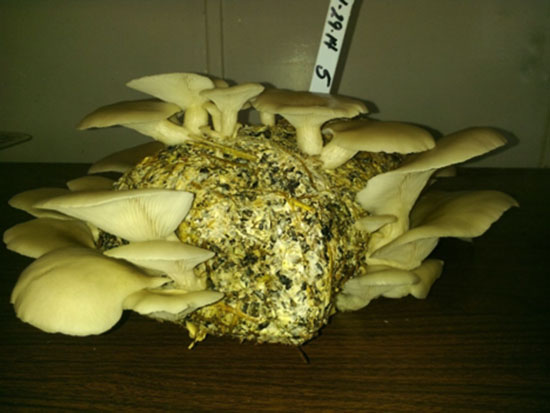
Oyster mushrooms at DSAC grown on cotton seed hull and straw.
Jeff Kindhart (618-695-2770; jkindhar@illinois.edu)
From southern Illinois ... Field conditions are very wet throughout southern Illinois from multiple rain events over the last week. Rain totals vary but range from 2-5 inches over the last week. The last few days have been cool ... 41 degrees this morning (Thursday, May 1). Hopefully this weather pattern will shift to warmer, dryer conditions next week.
Local orchards in the Jackson/Union county area are doing fairly well. Despite some cool weather (30-32 degrees) around peach bloom time, no major injury was observed. On average, peaches are currently at shuck split and apples are around petal fall. Blueberries started blooming around a week ago, and some later varieties still are in bloom. Local farmers markets are starting to open up, and many high and low tunnel tomatoes off to a good start (see picture below). Asparagus harvest is well underway.
Cover crops are finally starting to take off with the warmer conditions. Crimson clover is starting to show some blossoms, and the cereal grains are growing well. In the cover crop plot at the Jackson County Extension Office, I had planted an early maturing forage hybrid of cereal rye, and it is now headed out and getting very close to the time it should be terminated (see picture) below. This is about 2 or more weeks ahead of other cereal rye varieties. Make sure to continue to watch cover crops and terminate appropriately before mature seed is formed. Typically for cereal rye termination should be somewhere around anthesis (when the head has yellow pollen filaments hanging on it) to soft dough (seeds are soft and milky to slightly "doughy") at the very latest.
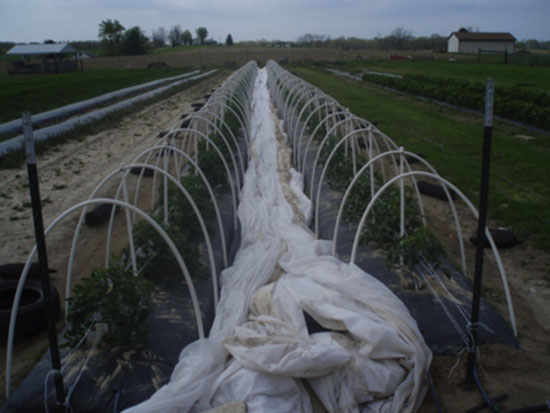
Low tunnel tomatoes in Randolph County. Photo courtesy of Bernie Colvis.
In general, after small grains shed pollen they are not growing vegetatively anymore, so regrowth is fairly minimal. Also given our wet soil conditions, remember that a growing cover crop is actually helping to pull moisture out of the ground, but once it has been killed that effect stops. If you need to terminate a cover crop due to its maturity but you are not ready to plant yet, consider spraying it and then letting it stand rather than rolling it down. Either can successfully terminate it, but if you roll the residue down it can trap a lot of moisture in the soil which can be very problematic on poorly drained soils, especially if we continue to receive more rain.
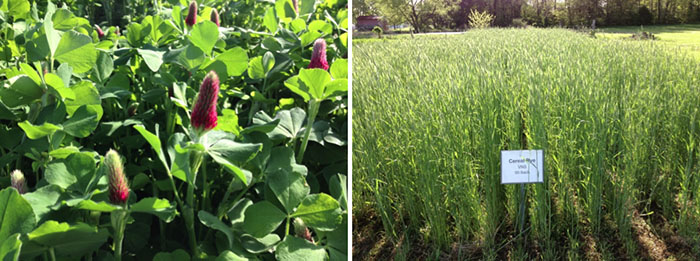
Left: Crimson clover in bloom. Right: Picture 3 -- Early maturing cereal rye. Planted late September, 2013.
Nathan Johanning (618-939-3434; njohann@illinois.edu)
From western Illinois ... Rains of April 27-28 ranged from less than an inch to over 3 inches. Soils were very dry, so the rains were welcome (mostly). Winds have been brisk for most of this spring, leaving little time for high tunnel placement of plastic. This would be a good time to remind your corn and soybean neighbors of spray drift and the concerns this can cause to your operation.
Field operations of the past week include: tillage, fertilizer and herbicide application, planting, laying of plastic/drip, etc. Most of the early crops have been planted outdoors: potatoes, onions, cole crops, greens, sweet corn, etc. High tunnel growers have tomatoes, peppers, green beans, greens, beets, carrots and a few other crops planted. A very few brave souls have transplanted some tomatoes outdoors as well, but most have elected to wait until warmer weather forecasts.
The negative 13 degree weather in January took care of nearly all the peach buds in Calhoun County and up through our area. I've got three peach trees in my back yard, only one had any buds, and there are less than 2 dozen of them. Pruning that tree to keep all the blossom buds and bloom resulted in an interesting looking tree.
In the Quincy area, plasticulture strawberries have been blooming for one to two weeks, and the early blooms that were not covered during mid-April were lost to freezing temperatures. Peaches (that survived) are at bloom. Apples are from pink to bloom. Blueberries are from tight cluster to pink. Bramble crops are variable, with some completely killed back to the soil line, while others seemed to have survived the January cold in mixed status, with some cane injury noted in nearly all varieties.
Asparagus harvest and rhubarb are stop-and-go with the warm temperatures followed by unseasonably cool temperatures.
Mike Roegge (217-223-8380; roeggem@illinois.edu)
2014 Season at the University of Illinois Plant Clinic
Welcome to another season of plant diseases! Samples have been steadily appearing this spring at the University of Illinois Plant Clinic ... now in our 39th year of operation. On the field front, there have been concerns with virus disease diagnosis in wheat. On the home landscape and fruit tree front, there is a mountain of winter kill and windburn injury from the harsh winter just past.
The University of Illinois Plant Clinic began year-round operation in the fall of 2011. Our new location is in Jonathan Baldwin Turner Hall on the south end of the Urbana campus. During the winter, our hours were irregular due to trainings and winter meetings, but we resumed regular business hours, 8 a.m. - 12 p.m. and 1p.m. - 4:30 p.m., on Monday April 28, 2014.
Plant Clinic services include plant and insect identification, diagnosis of disease, insect, weed and chemical injury observations (chemical injury on field crops only), nematode assays, and help with nutrient-related problems, as well as management recommendations involving these diagnoses. Microscopic examinations, laboratory culturing, virus assays, and nematode assays are some of the techniques used in the clinic. Many samples can be diagnosed within a day or two. Should culturing be necessary, isolates may not be ready to make a final reading for as much as two weeks. Nematode processing also requires about 1-2 weeks, depending on the procedure. We send your final diagnoses and invoices to you through both the US Mail and email. If you provide your email address on the sample form, you will get your information earlier.
Please refer to our website http://web.extension.illinois.edu/plantclinic/ for additional details on sampling, sample forms, fees and services offered. If you have questions about what, where, or how to sample call us at 217-333-0519. Whenever submitting a sample, provide as much information as possible on the pattern of injury in the planting, the pattern on individual affected plants, and details describing how symptoms have changed over time to cause you concern.
Our fees vary depending on the procedure necessary. General diagnosis including culturing is $15, ELISA and immunostrip testing is $25, nematode analysis for SCN or PWN is $20, Specialty nematode testing (such as corn) is $40. Please include payment with the sample for diagnosis to be initiated. Checks should be made payable to the University of Illinois or to the Plant Clinic. Companies can setup an account ... call, and we will accommodate you. Also call if you are uncertain of which test is needed.
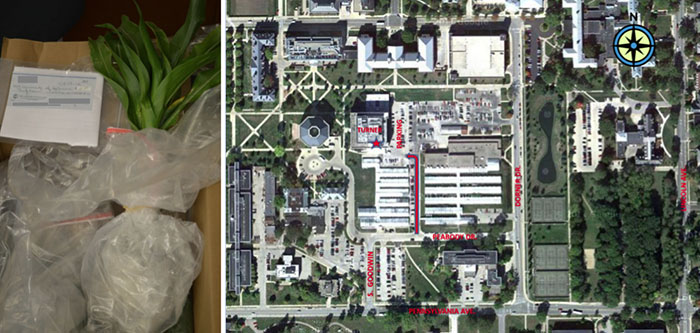
Left: Example of a great sample ... sample form, symptomatic plant, protected root ball and payment. Right: Location of Turner Hall, where the Plant Clinic is located.
If you send a sample through US Mail or a delivery service, address it to:
University of Illinois Plant Clinic
1102 S. Goodwin, S-417 Turner Hall
Urbana, IL 61801
If you want to drop off a sample, bring it to S-417 Turner Hall. Park in the metered lot (F 28) on the east side of Turner or at the ACES library metered lot on the west side of Turner. Come in the south door. Take the elevator located in the SE corner of the building. Turn left when exiting the elevator; we are located along the SE corridor of the 4th floor. Please use the green drop box located just outside S-417 if we are temporarily out of the office.
We have a lot of ways to keep you up to date on what is happening at the Plant Clinic and about other plant and pest issues. Follow the U of I Plant Clinic on Facebook at http://www.facebook.com/UofIPlantClinic, YouTube at http://tinyurl.com/clinicyoutube, or Blogger at http://universityofillinoisplantclinic.blogspot.com ... keywords: Plant Clinic, Diagnostics, Plant Disease.
Suzanne Bissonnette (217-333-0519; sbissonn@illinois.edu)
Fruit Production and Pest Management
Biology and Management of Grape Phylloxera
(Adapted from a 2013 article in this newsletter) Grape phylloxera is a common and damaging pest of grapes throughout Illinois and the region. Overwintered eggs on grape trunks hatch in the spring (in early to mid-April in most years in far southern Illinois, but probably just recently this year; and a few weeks later in northern Illinois), and immature stages called "crawlers" infest the first to third expanding terminal leaves. Leaves form a gall around each crawler. These crawlers mature to become egg-laying adults that produce 100 to 300 eggs each. Crawlers that hatch from these eggs crawl up to new terminal leaves and infest them (usually the 5th through 8th leaves on the shoot), often resulting in 50 or more galls per leaf. These crawlers are the targets of early season insecticide applications intended to reduce phylloxera damage. Timely scouting and timely application of effective insecticides are keys to controlling grape phylloxera. A detailed guide to understanding and controlling grape phylloxera, Biology and Management of Grape Phylloxera, written by Dr. Donn Johnson, Sandra Sleezer, and Barbara Lewis of the University of Arkansas, is available online at http://www.uaex.edu/Other_Areas/publications/PDF/FSA-7074.pdf. Grape growers are urged to consult this publication, study its contents, and develop an effective management program. Listings of registered and effective insecticides for phylloxera control are on pages 20 and 34-35 of the 2014 Midwest Small Fruit and Grape Spray Guide.
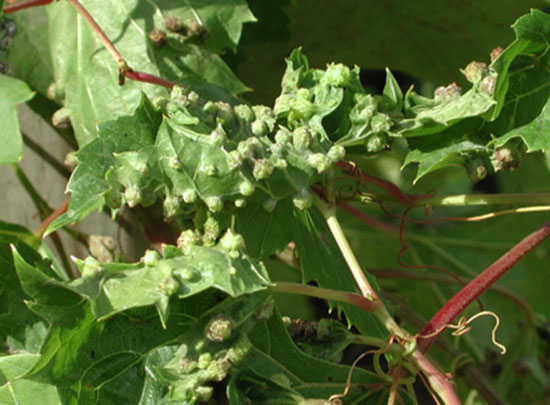
Grape phylloxera galls on leaves (University of Minnesota).
Rick Weinzierl (217-244-2126; weinzier@illinois.edu)
Oriental Fruit moth and codling moth
Captures of oriental fruit moths in traps at Urbana indicate the biofix (date that starts the degree-day model) for this insect here for 2014 was April 26. Apples here are just starting to bloom (variety-dependent), and we have not yet caught any codling moths in traps at the U of I research orchard. In the mid-May issue of this newsletter, I'll include phenology updates for all locations where I have biofix dates for these two insects ... so if you are using traps to monitor oriental fruit moth or codling moth (or other fruit insects), please send me your observations of biofix dates (first sustained captures in traps), and I'll include your location in the updates.
Rick Weinzierl (217-244-2126; weinzier@illinois.edu)
Insecticides for Plum Curculio Control
Petal fall is the recommended timing for insecticide applications intended to control plum curculio. We're using a wrap-around trap made of hardware cloth on trunks to monitor movement of plum curculio up apple and peach trees at Urbana, and although apples are just beginning to bloom, we have been capturing plum curculio adults in the traps for about a week. When fruit begins to form, plum curculio females will begin chewing slits in the fruitlets and laying eggs into those slits. Petal fall – when bloom is done and bees are no longer foraging – is the earliest that growers can use insecticides for plum curculio control. Imidan, Avaunt, and Assail are among the most effective insecticides for curculio at petal fall. All are at least moderately toxic to bees, so be sure to delay applications until bees are no longer in the orchard. The 2014 Midwest Tree Fruit Spray Guide (https://store.extension.iastate.edu/Product/2014-Midwest-Tree-Fruit-Spray-Guide ... download the pdf) also lists Belay and Actara for curculio control, but these two insecticides are MUCH more toxic to bees, and I discourage growers from using them at this time, especially if some late bloom is still attracting pollinators.

Left: plum curculio (Clemson University); center: crescent-shaped slits on a small apple (West Virginia University) ... eggs are laid into these slits; right: egg-laying scars as they appear later on mature apples (University of Kentucky).
Rick Weinzierl (217-244-2126; weinzier@illinois.edu)
Vegetable Production and Pest Management
Corn Earworm Management in Sweet Corn ... an Update for 2014
Corn earworms are often the most damaging insect in Illinois sweet corn. They overwinter in the pupal stage in the soil, but their survival rate is very low in most of the state – with the winter of 2014, there almost certainly was nearly no survival in most Illinois locations. It manages to be a severe pest every year anyway because it migrates in from southern states on weather fronts every summer. Moths are almost always active in the Collinsville area (where overwintering success in most years is greater) by late May and early June, but in much of the state the period of first activity (and the first need to control them) can vary from June through August, depending on the time of their migration. Although control may be necessary in one portion of the state at a particular time, it may be unnecessary in many other locations. Consequently, it really is essential to establish a monitoring program to determine spray needs. Unfortunately, scouting for foliar damage or larvae on the surface of plants is not an option. Corn earworm moths lay their eggs singly on silks, and larvae move down the silk channel immediately after they hatch from the eggs (and hatching can occur in as little as 2 ½ days during hot weather). On corn, larvae do not feed on any exposed parts of the plant (leaves, husks, etc.), so the only practical way to kill them (short of having planted BT sweet corn, which does not provide 100 percent control) is with a contact insecticide applied to the silks. Larvae crawl across the residues on the silks, and the insecticide is taken up through the cuticle.
Effective monitoring programs depend on the use of pheromone-baited traps that catch male corn earworm moths and are used as indicators that adults of both genders are present and eggs are being laid. Previously we have recommended using either a wire Hartstack trap (pictured below) or a nylon version of the same general design marketed by Scentry and several regional distributors. We've long known that paper sticky traps are ineffective at monitoring corn earworm moths, and in recent years evidence indicates that the Scentry nylon cone traps may not work well enough. Results from monitoring work done in 2006 showed that the nylon traps also may fail to detect light but still significant flights when the wire Hartstack traps do catch moths. Consequently, I now recommend that all sweet corn and seed corn producers use the wire Hartstack trap. (Data to support this recommendation came from a regional monitoring effort coordinated by Bill Hutchison of the University of Minnesota and conducted by several entomologists and horticulturists who participate in the Great Lakes Vegetable Workers Group.) Traps should be baited with Hercon "zealures," and the lures need to be replaced every 2 weeks. Earworm control is necessary when moth flight is ongoing and fresh silks are present. If traps are catching more than a few moths (3 to 5 per trap per night) when silking begins, sprays should be applied within 2 days after first silk -- insecticide residues must be on the silks to kill larvae immediately after they hatch from eggs and before they enter the silk channel. If the only silking corn in your area is your field, the threshold for treating should be revised down to 1 moth per trap per night.
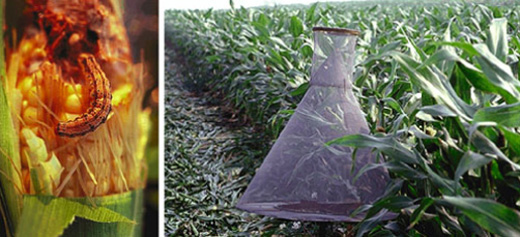
Left: Corn earworm larva. Right: Hartstack trap.
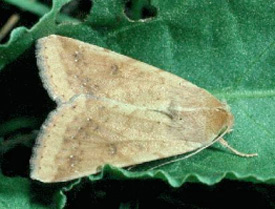
Corn earworm moth (Kansas Department of Agriculture).
A Midwest supplier of the Hartstack trap for earworms is Bob Poppe, Route 1, Box 33, Lexington, IL, 61753 (309-723-3201). I suggest that you buy an extra top cylinder for each trap to make handling more efficient. Lures are available from Great Lakes IPM (10220 Church Road NE, Vestaburg, MI 48891; 989-268-5693; 989-268-5911; 800-235-0285; FAX: 989-268-5311) and Gemplers (1-800-382-8473). As I have pointed out in previous seasons, the wire Hartstack trap is not cheap ... think in the $300 range plus shipping, and think higher numbers if the traps must be shipped a long way. But before you let the price tag make you baulk, consider ...
- These traps will last for many years (I have a couple that are over 30 years old) ... as long as you don't run over them with tractors or other vehicles.
- Along with a few dollars for lures every year and daily monitoring of moth counts, they provide you with guidance that can keep you from spending thousands of dollars unnecessarily or losing thousands of dollars' worth of sweet corn sales. If you spray 10 acres of sweet corn even twice a week for 3 weeks before earworms are actually present and require control, that's 6 applications at (conservatively) $20.00 per acre for each application if you use something that's effective ... multiplied by 10 acres, that's $1,200 (plus the loss of time not spent doing something more necessary). Multiply that by a 20-year life span for the trap, and the total exceeds $24,000. I think that pays for the trap and the lures. Viewed in a different way, if high trap counts lead you to spray more often in order to get the control you really need, you market more corn. For a fresh-market producer who sells sweet corn at $4.00 per dozen, a yield of 1,200 dozen per acre is worth $4,800. Preventing a 5 percent loss by spraying extra when needed saves $240 per acre in sales. Multiply that by 10 acres and 20 years, and the total reaches $48,000 ... that, plus keeping your customers from complaining about wormy corn, certainly pays for the cost of a trap and a package of lures every year.
Insecticide and "trait" choices for corn earworm control in 2014
First, insecticides ...
- The goal of insecticide applications in sweet corn is to put a residue on fresh silks that kills larvae before they can move from the egg on the silk to the tip of the ear. (If sprays kill some adults, that's a benefit, but that's NOT what makes an effective spray program.) This means that sprays must be applied repeatedly as the silks elongate. Although the residual activity of many insecticides is several days, newly emerged portions of silks near the ear tip were not exposed to the sprays applied a couple of days earlier. This is why sprays are recommended on 2- to 3-day intervals as long as silk growth continues. If traps are catching just few moths and temperatures are moderate, a 3-day spray interval can be adequate. If traps are catching 30 or more moths per night and temperatures are in the 90s, spraying every 2 days will be necessary to produce corn with very few damaged ears. Sprays should begin within 2 days after silk have begun to emerge if moths were flying when silks appeared.
- At least some of the corn earworm populations that migrate into the region are resistant to pyrethroids (Baythroid, Brigade, Hero, Mustang Max, Warrior, and their generic versions). Alternatives to pyrethroids – such as Belt, Coragen, Entrust (for organic growers), and Radiant – are not quite as effective as the pyrethroids used to be before resistance development. Where markets demand corn that is nearly worm-free, relying on a pyrethroid or an alternative alone is not likely to give adequate control when moth flights are high. Combinations of a pyrethroid plus one of these alternatives or a pyrethroid plus Lannate are likely to give the best results. If you take this approach and tank-mix two different kinds of insecticides, use each at their label rates (often the middle of range listed on each product's label). Making timely applications on the right interval (2 or 3 days) is FAR more valuable than using the highest possible rates. A pre-mix of the active ingredients in Warrior (lambda-cyhalothrin) and Coragen (chlorantraniliprole) will be sold in 2014 under the trade name Besiege. It provides an alternative to tank-mixing two different chemicals.
What about Bt sweet corn varieties?
- From a grower's perspective, there are three different categories of Bt sweet corn varieties on the market or soon to come to market. (1) The Attribute series sweet corns produce one kind of Bt toxin. It is very effective against European corn borer and corn earworms. The "problem" is that only 3 of 4 kernels on ears in Attribute series Bt sweet corn fields produce the toxin (a result of the heterozygous nature of the genetics of the variety and random recombination in the offspring – the kernel). Additionally, the Bt toxin in the Attribute series is not very effective against black cutworm or western bean cutworm (or rootworms or sap beetles). (2) The Seminis "Performance" series of Bt sweet corn varieties produces two toxins that kill Lepidopteran larvae; they also have genes for corn rootworm larval resistance and resistance to Roundup. The second Bt toxin in these varieties provides much greater resistance to black cutworm, fall armyworm, and western bean cutworm (as well as European corn borer and corn earworm). However, only 3 of 4 kernels on ears in Performance series Bt sweet corn fields produce the toxin (again, a result of the heterozygous nature of the genetics of the variety and the fact that the genes for the two toxins are linked and so they move together in the random recombination of genes in the offspring – the kernel). (3) A new "Attribute II" series of sweet corn varieties is under development by Syngenta. Varieties that will be available for sale in 2014 are not the ones that most fresh-market growers in Illinois will plant. In the Attribute II series, genes code the production of two very different toxins that kill Lepidopteran larvae (cutworms, armyworms, European corn borer, and corn earworm). These genes are not linked, and as a result, 15 of 16 kernels on ears in Attribute II series Bt sweet corn fields produce one or both toxins.
- Do Bt sweet corn varieties still need to be treated with insecticides? Yes. Although the Attribute II series will suffer less damage when untreated than existing Bt varieties, this technology will not be available in 2014 in varieties that most Illinois producers grow. The original Attribute series and the Performance series varieties must be treated when corn earworm moth flights are heavy or if western bean cutworm is present. The jury is still out on the characteristics of a reduced spray program that would adequately protect these varieties. In varieties with long silk channels, early sprays might be skipped (because larvae would ingest Bt toxins as they feed on silks while moving toward kernels). Bt concentrations decline somewhat in silks after pollination, and as ears elongate and kernels have less cover, sprays may be more necessary. The point for now is simple ... do be prepared to use insecticides on Bt sweet corn if it must be worm-free for your markets.
Rick Weinzierl (217-244-2126; weinzier@illinois.edu)
Useful Guides on Vegetable Diseases
We often refer you to identification guides for diseases of specific crops or groups of crops. You might want to add a bookmark to your web browser for Seminis' disease guides for onions, crucifers, tomatoes, and peppers and eggplants. These are global guides, so they include some diseases that do not occur in Illinois or the Midwest, but they are useful references nonetheless. See http://www.seminis.com/global/us/growerresources/Pages/Disease-Guides.aspx.
Kyle Cecil (309-342-5108; cecil@illinois.edu)
Local Foods Issues
Arthur Produce Auction
The Arthur Produce Auction is held every Tuesday & Friday in Season (May - October) beginning at 10:00 a.m. The auction is open to the public and to the trade (grocers, restaurants, and wholesalers). Location: 1/2 mile east of Arthur on State Rte. 133 to 100 East Road, then 1/2 mile south on the west side of the road. Produce is sold in lots of three boxes up to pallet quantities. To get on their email list, send a note to abcshop@agapemail.com or leave a voice mail message at 217-543-5100.
Mary Hosier (217-333-7512; mhosier@illinois.edu)
How many acres of vegetables can I farm?
This is one of the most commonly asked questions I get from new growers considering how they can become vegetable farmers. While it is difficult to give one answer than covers all situations, we can look to case study research to help us get an idea of how to answer the question. Research from the University of Wisconsin (http://www.cias.wisc.edu/wp-content/uploads/2008/07/grwr2grwr.pdf ) attempted to shed light on this question. The cases they looked at were varied, but limited in overall number of farms. So we look to the data to help give us an idea of what a possible answer might be. Labor hours on the market gardens in the study with fewer than three acres ranged from 933 to 2,994 hours per acre, and averaged just under 2,000. Three- to twelve-acre market farms in this study ranged from 402 to 1,443 labor hours per acre and averaged just under 850. Farms under six acres averaged 1,000 labor hours per acre, while farms over six acres averaged 707 hours per acre. What is interesting in this study is that the smaller farms, though exhibiting significant labor cost per acre, tended to sell value-added specialty items to a targeted clientele. This shows us that size and scale are not only related to the amount of labor we have to devote to vegetable farming, but they are also related to what market we intend to pursue. We may not need to grow 25 acres of crops if we intend to work with only a few specific restaurants or vendors that pay a premium for the produce we can provide.
Kyle Cecil (309-342-5108; cecil@illinois.edu)
Less Seriously ...
The owner of a small deli was being questioned by an IRS agent about his tax return. He had reported a net profit of $80,000 for the year.
"Why don't you people leave me alone?" the deli owner said. "I work like a dog. Everyone in my family helps out, the place is only closed three days a year. And you want to know how I made $80,000?"
"It's not your income that bothers us," the agent said. "It's these deductions. You listed six trips to Bermuda for you and your wife."
"Oh, that," the owner said smiling. "I forgot to tell you -- we also deliver."
University of Illinois Extension Specialists in Fruit and Vegetable Production & Pest Management
Extension Educators – Local Food Systems and Small Farms |
||
Bronwyn Aly, Gallatin, Hamilton, Hardin, Pope, Saline, and White counties |
618-382-2662 |
|
Katie Bell, Franklin, Jackson, Perry, Randolph, & Williamson counties |
618-687-1727 |
|
Sarah Farley, Lake & McHenry counties |
847-223-8627 |
|
Nick Frillman, Woodford, Livingston, & McLean counties |
309-663-8306 |
|
Laurie George, Bond, Clinton, Jefferson, Marion, & Washington counties |
618-548-1446 |
|
Zachary Grant, Cook County | 708-679-6889 | |
Doug Gucker, DeWitt, Macon, and Piatt counties |
217-877-6042 |
|
Erin Harper, Champaign, Ford, Iroquois, and Vermillion counties |
217-333-7672 |
|
Grace Margherio, Jackie Joyner-Kersee Center, St. Clair County |
217-244-3547 |
|
Grant McCarty, Jo Daviess, Stephenson, and Winnebago counties |
815-235-4125 |
|
Katie Parker, Adams, Brown, Hancock, Pike and Schuyler counties |
217-223-8380 |
|
Kathryn Pereira, Cook County |
773-233-2900 |
|
James Theuri, Grundy, Kankakee, and Will counties |
815-933-8337 |
|
Extension Educators – Horticulture |
||
Chris Enroth, Henderson, Knox, McDonough, and Warren counties |
309-837-3939 |
|
Richard Hentschel, DuPage, Kane, and Kendall counties |
630-584-6166 |
|
Andrew Holsinger, Christian, Jersey, Macoupin, & Montgomery counties |
217-532-3941 |
|
Extension Educators - Commercial Agriculture |
||
Elizabeth Wahle, Fruit & Vegetable Production |
618-344-4230 |
|
Nathan Johanning, Madison, Monroe & St. Clair counties |
618-939-3434 |
|
Campus-based Extension Specialists |
||
Kacie Athey, Entomology |
217-244-9916 |
|
Mohammad Babadoost, Plant Pathology |
217-333-1523 |
|